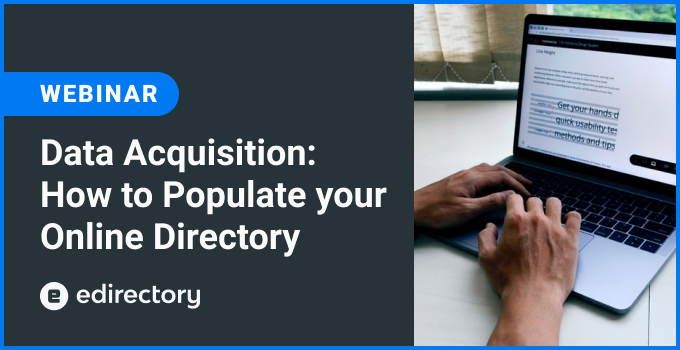
If you’ve ever tried launching or growing an online directory, you’ve probably hit the same roadblock many directory owners face: Where do you get the data?
You need listings. Not just any listings, but accurate, up-to-date, and engaging listings that will keep your users coming back. That’s why we hosted a live webinar titled “Data Acquisition to Populate Your Directory Website”—to help entrepreneurs and digital marketers tackle this crucial challenge head-on.
Whether you missed the live session or want a quick refresher, this post brings together the best insights and actionable advice from the presentation.
Data is the most valuable asset of online directories. On this Webinar with our CEO James Chubb, learn more about how to get business data to populate your online directory and the best practices on listing management.
Why Data Acquisition Is Critical for Online Directories
Building a directory is about more than just creating a platform—it’s about creating trustworthy, useful content that helps people make better decisions.
Here’s why it matters:
-
Quality beats quantity. Everyone can list businesses. But deep, curated, and personalized content creates value.
-
Commodity content is everywhere. Your voice, your curation, and your storytelling are your biggest assets.
-
AI and search engines favor curated content. They’ll send visitors your way if your site offers more than the basics.
Data Acquisition – How to Populate your Online Directory
Step 1: Set Clear Data Goals
Before you start collecting data, define what success looks like for your site:
-
Breath Goal – How many listings do you want per category or region?
-
Depth Goal – How much information should each listing contain? Think: contact info, custom descriptions, photos, videos, testimonials, and more.
Start small. Choose a niche or city, launch with the minimum viable listings, and build continuously from there.
Step 2: Where to Find Quality Data
There’s no shortage of data sources—you just need to know where (and how) to look:
🗃️ Public and Commercial Sources:
-
Government databases – Business registrations, permits, and licenses.
-
Trade associations – Industry-specific lists and contacts.
-
Chambers of Commerce – Often offer regional member lists.
-
Data vendors – Companies like Data Axle and Dun & Bradstreet offer bulk data (by record or subscription).
🛠️ Web Scraping Tools (Use Responsibly):
-
Octoparse – A no-code scraping tool with scheduling.
-
ParseHub – Visual interface, beginner-friendly.
-
Apify – Pre-built scrapers and automation.
-
Instant Data Scraper – Easy-to-use browser extension.
Step 3: Estimate the Size of Your Niche
To plan your effort and budget, you need to know how many listings to aim for. Here’s how:
-
Search smart: Google terms like “how many restaurants in Austin” to get ballpark figures.
-
Extrapolate: If a city of 100k residents has 300 restaurants, a city of 1M might have 3,000.
This gives you a realistic estimate and helps you plan resource allocation.
Step 4: Clean and Enrich Your Data
Once you’ve gathered raw data, it’s time to make it your own:
Tools for Enrichment:
-
ChatGPT, Google Gemini, Grok – Use AI to write descriptions, format listings, and add missing data (carefully!).
-
Google Sheets & Excel – Ideal for organizing and cleaning large datasets.
-
Custom descriptions & multimedia – Add a human voice, visuals, and unique structure to stand out.
Export → Improve → Re-import: Make your workflow efficient and scalable.
Go Deep, Not Wide
One of the biggest takeaways from the webinar? Don’t try to be everything to everyone.
Instead:
-
Go category by category, market by market.
-
Prioritize depth over breadth—users want detailed, trustworthy, decision-making content.
-
Your custom content becomes your moat—something AI and generic directories can’t replicate.
Step 5: Legal and Ethical Considerations
Respect is not optional—it’s essential.
-
Read and follow the Terms of Service.
-
Always credit data sources when required.
-
Avoid using proprietary or copyrighted lists.
-
Follow privacy laws like GDPR when collecting user data.
Taking the high road builds a sustainable, trusted platform.
Conclusion: Build with Purpose, Grow with Precision
Populating your directory website isn’t just about collecting data—it’s about curating information that’s useful, trustworthy, and tailored to your audience. With the right tools, ethical practices, and a commitment to quality over quantity, you can create a directory that doesn’t just exist, but thrives.
Remember:
-
Start with a clear strategy.
-
Focus on depth before scale.
-
Use automation and AI responsibly.
-
Always add your unique voice.
Whether you’re launching your first niche guide or scaling a national directory, the path to long-term success starts with smart data acquisition. And as today’s digital landscape becomes increasingly AI-driven, your curated content becomes your competitive edge.
Ready to take the next step? Join our upcoming webinars, ask questions, and let’s grow your directory—one valuable listing at a time.
This session was recorded on April 30th, 2025.
- Don’t forget to register for eDirectory’s next Webinar.
- Do you want to know what eDirectory can do for you? Sign up for a free guided Demo here.
Want more tips? Shoot us a note at marketing@eDirectory.com and don’t forget to join our Facebook group.


